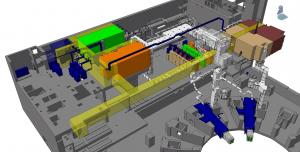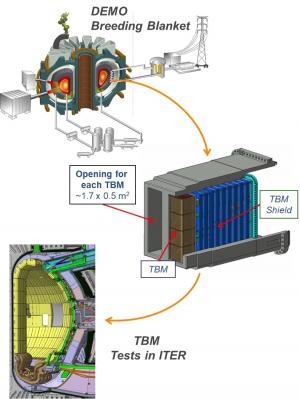Technology
Perfecting tritium breeding for DEMO and beyond
18 May 2020
-
Pat Brans
While ITER will never breed tritium for its own consumption, it will test breeding blanket concepts—the tools and techniques that designers of future DEMO reactors will need to achieve tritium self-sufficiency.
Four test blanket modules, each containing a lithium compound, will be plugged into two different equatorial ports of the machine. The modules (lower right) are only "the tip of the iceberg," and require complex ancillary systems to remove heat, manage coolant, and extract and process tritium.
Because a tritium breeding blanket will be a fundamental feature of commercial fusion reactors, several ITER Members are now participating in the ITER Test Blanket Module (TBM) Program, which aims to test mockups of relevant DEMO* blanket systems
To improve coordination and accelerate decision-making, the ITER Council endorsed the TBM Project Team (TBM-PT) in June 2017. Mario Merola, head of the Internal Components Division, has led the team since 1 January 2020.
Evaluating and testing design options
One of the jobs of the TBM-PT is to assess the test blanket system designs proposed by ITER Members, and ensure that each design meets requirements and integrates with other ITER systems. The TBM-PT will also oversee the fabrication, installation and operations of the various system concepts.
Test blanket modules are steel boxes that face the plasma, measuring approximately 1.7 x 0.5 x 0.6 metres. Four of them will be plugged into two different equatorial ports of the machine, each containing a lithium compound. The neutrons spewing from the plasma will strike the lithium to initiate a nuclear reaction that produces tritium, helium and heat. In a DEMO reactor, the tritium will be extracted and used as fuel, the helium will be a harmless byproduct, and the heat from the reaction will be used to produce more electricity—a bonus of up to 20 percent more output from the plasma fusion power.
ITER's in-vessel test blanket modules are designed to represent the main features of a DEMO tritium breeding blanket—e.g., geometry, configuration of breeder/multiplier, temperature, pressure, and process flows including cooling and tritium extraction. The final objective is to provide enough information to successfully design, qualify and operate a breeding blanket and associated systems in DEMO.
"I think of the test blanket modules as the tip of the iceberg," says Merola. "Behind the steel boxes are enormous ancillary systems." Some of these systems will extract the tritium, process it, and account for it. Others will remove the heat and channel it to where it can be used to demonstrate the feasibility of generating electricity in a future fusion power plant. Still other systems will purify the coolant and take measurements to monitor the test blanket systems, and collect essential data that can be extrapolated to help in designing DEMO blankets.
The four different test blanket systems (module plus ancillary systems) that will be installed in ITER will be used to test different combinations of design options: a liquid metal breeder versus solid breeders, and helium coolant versus water coolant.
The liquid breeder is lithium-lead, which becomes liquid at 235 °C. The main advantage of this breeder is that it can be refueled during operation. But a challenge is that liquid breeders interact with the magnetic fields. To overcome this problem, the lithium-lead has to either flow at a low velocity or be electrically isolated from the metallic walls.
Solid breeders do not interfere with magnetic fields, but they cannot be refilled online. Instead, they have to be replaced from time to time—an operation that requires the reactor to be stopped so the exhausted breeder can be replaced.
As far as coolants go, water has the advantage of being well known through years of use in fission reactors. But water has one big disadvantage when it comes to extracting heat: without high pressure, water cannot be raised to the temperatures needed for efficient conversion between thermal and electric energy. Helium, on the other hand, can be brought up to 500 to 600 °C, but it has the disadvantage of a much lower heat capacity. To compensate, a higher flow velocity is required, which means higher pumping power.
Improving the models to inform future designs
Simulations can be used to predict the behaviour of the test blanket systems, but the models underpinning the simulations have to be validated through a set of experiments. These experiments on ITER will also help to further understand the parameters that can be used to tune the breeding process. "There are different ways of tuning the efficiency of tritium production," says Merola. "For example, altering the density of the breeding material or using neutron multipliers. There are also different ways of tuning the process of extracting the tritium, of separating it from other gases, and of re-injecting it into the plasma."
The ITER TBM Program will test the test blanket systems separately in order to determine the advantages and drawbacks of each concept. The program will also gain experience over the years to help determine which components need to be replaced, and how often. "These are all things that are not yet fully understood, because there is no breeder blanket tokamak anywhere in the world," says Merola. "We will be on the front line of fusion research, taking an essential step towards DEMO."
*DEMO: the general term for next-phase DEMOnstration fusion reactor projects. Different conceptual DEMO projects are under consideration by all ITER Members.



